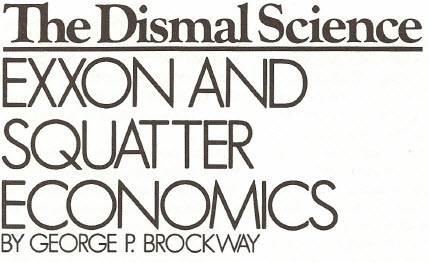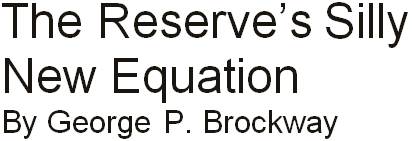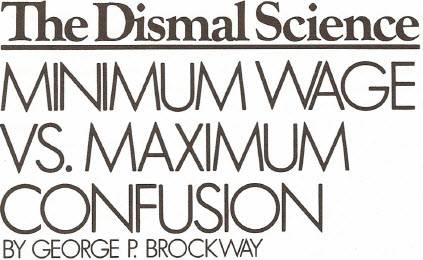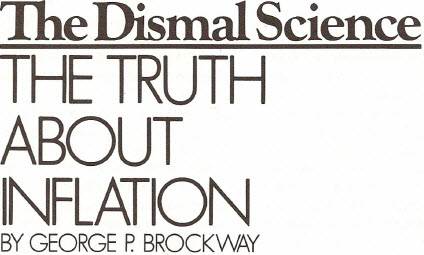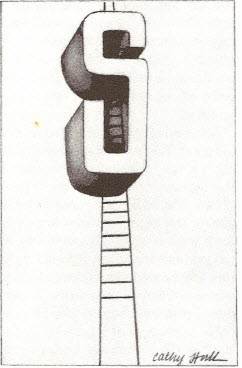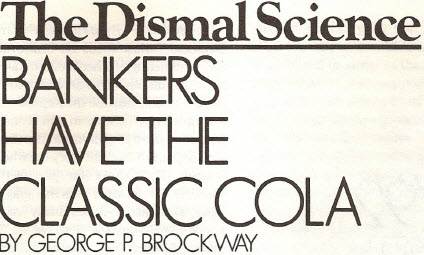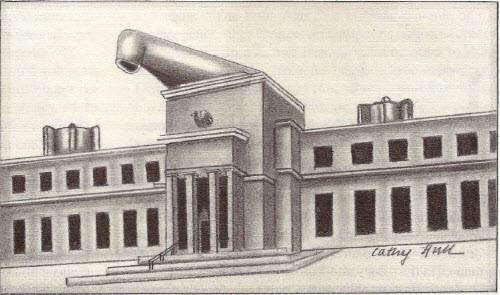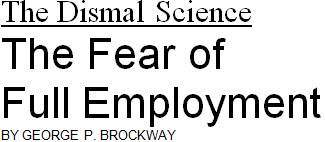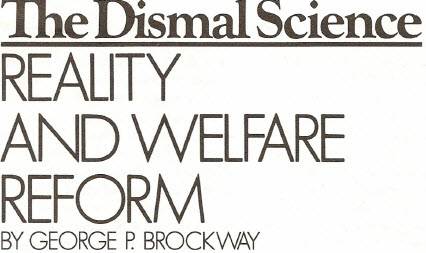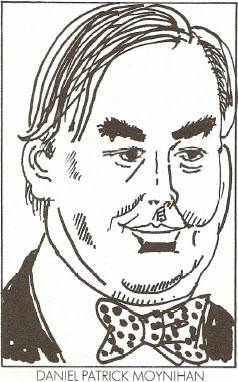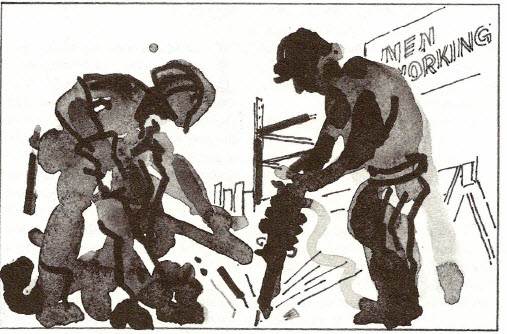By George P. Brockway, originally published August 7, 1989
DEAN ACHESON once remarked wearily that if anyone, at any time, found him agreeing with any Indian on any subject whatever, that person should have him certified immediately. His judgment was no doubt colored by his experiences with V.K. Krishna Menon, who wanted all North Korean POWs shipped home whether they wished to go or not.
My feelings about standard economics are similar, perhaps because one summer, in a youthful fit of self-improvement, I spent many hours reading Frank Taussig’s introductory textbook when I could have been sleeping in the sun. My recollection is that Taussig, who was a big man in his day, started off by talking about Robinson Crusoe. I have since come to doubt that Robinson had anything to do with economics at all. So far as I know or Professor Taussig said, he never bought or sold anything, or used money.
One by one the classic laws have lost their savor for me. David Ricardo‘s Law of Comparative Advantage was an early loser, and I wrote three columns[1] about it six or so years ago. The notion that producers are profit maximizers and consumers are utility maximizers attracted my attention last year, and the Law of Diminishing Returns a couple of months ago. I’ve even dropped a hint or two concerning the Law of Supply and Demand, and might supply a column about it, if I detected any demand.
I’m ashamed to say that in one of my early columns I made a slip and endorsed the proposition that free competition in a free market makes for the most efficient allocation of scarce resources. As Abraham Lincoln[2] replied when requested to apologize for saying that Simon Cameron would not steal a red-hot stove, I now take that back.
The issue is in the news because of the great Valdez oil spill. Some excitable people want to punish Exxon, but they have been patiently told it would be inefficient to do so. Encouraged by the sound of their own voices, the naysayers add that it would be inefficient to impose further restrictions on the exploitation of Alaskan oil, and also that an increase in the gasoline tax would distort the allocation of resources. They urge, too, a relaxation of the already relaxed standards of gasoline efficiency (that word again) for new automobiles. Red-blooded Americans, if given their druthers, would prefer very big cars that can go very fast; therefore they should be allowed to put their money where their preference is, and the speed laws should be lifted while we’re at it.
The more beguiling advocates of free market theory admit that sooner or later oil will run out. They are confident, however, that the spur of possible profits will drive some mad scientist to invent a way of using crab grass or zucchini for fuel (as some tried to use dandelions for rubber in World War II), thus rehabilitating suburban agriculture and saving the automobile. In the meantime, they argue, as oil gets scarcer and the price rises higher, those willing to give up coarser pleasures are entitled to enjoy the daintier pleasure of burning gasoline in fast cars, fast boats and fast snowmobiles. Their willingness shows that is the efficient thing to do.
Let’s examine the proposition, not from the point of view of ecology or even of national security (where it’s a clear loser), but from the point of view of logic. Is economics really about the allocation of resources at all? To answer that question, we have to be able to say what a resource is. How about this: A resource is something that is useful or necessary to make something else, a component of an economic commodity.
(At this point there is a side issue we ought to deal with. The Education President tells us that a trained labor force is an essential resource in our struggle with Japan and Germany for the hearts and moneys of the world. But a labor force is not a thing; it is human beings, and human beings are ends in themselves. Trade is for human beings; human beings are not for trade. They are not a resource or a means to anything else. To treat human beings as means is the ultimate sin. I know that George Bush is a kind and gentle man who does not always mean exactly what he says. But if we are to read his lips, he should watch his tongue.)
So resources are things, objects. Natural resources are things untouched by human hands, lying around ready to be picked up or dug up or fished up, and used. Economic resources are also scarce. There is no point in talking about them if they are not scarce. Taussig (if my memory serves after all these years) gave air as an example of a noneconomic resource, the reasons being that there was a lot of it, and that no one could figure out how to bottle it and sell it. We’ve made progress, however. If you’re in the hospital and they decide to pep you up with oxygen, you’ll find $100 a day added to your bill. And Los Angeles knows that breatheable air would be impossibly expensive.
But of course not all scarce natural objects, even those that could be readily packaged, such as bluebird nests, are natural resources. Leon Walras, the patron saint of marginal utility analysis, credits his father Auguste with the notion that an economic good has to be useful as well as scarce. This does not seem a remarkably difficult advance in thought. It does not really advance us very far, either.
Maybe you are not clever enough to think up uses for bluebird nests, and maybe no one is; that does not mean a use will never be discovered or invented. Think of petroleum. If you had asked Adam Smith about it, he would have shrugged his Scotch shoulders. It was a sticky, stinky substance where it appeared, as in the notorious fields near Cumae, rendering useless the land that harbored it. Or you might have asked Karl Marx about uranium. He would never have heard of it, for one thing. What kind of resource is something you never heard of. On the other hand, ancient man mined and traded obsidian, which, apart from the art and tools the ancients made of it, is now of no interest to a Harvard Business School graduate.
From these random samples we can infer that the usefulness of objects is not something inherent in them. As it happens, there is no dispute on this point. W. Stanley Jevons, who shares with Walras the distinction of having invented marginal utility, put it this way: “The price of a commodity is the only test we have of the utility of the commodity to the purchaser.” A half century earlier Jean- Baptiste Say had characteristically introduced an intermediate and indeterminable abstraction: “Price is the measure of the value of things, and their value is the measure of their utility.”
In our day, Gerard Debreu, a Nobelist and probably the world’s foremost mathematical economist, is in agreement with Jevons and Say. “The fact that the price of a commodity is positive, null, or negative,” he writes, “is not an intrinsic property of that commodity; it depends on the technology, the tastes, the resources … of the economy.”
(Please forgive another side issue. Noting the word “resources” before Debreu’s ellipses, I confess myself puzzled, since in a subsequent passage he says, “The total resources of an economy are the a priori given quantities of commodities that are made available to (or by) its agents.” It would appear that the price of a commodity depends, at least in part, on resources, and that resources are commodities-a line of argument that looks suspiciously circular to me.)
ONE WAY or another, then, we come to the conclusion that it is not so easy to say what economic resources are. They are useful, yes, but neither petroleum nor uranium nor a bluebird nest is, in and of itself, useful. Indeed, if you don’t know how to use them petroleum is nasty and uranium is dangerous. But our economy does know how to use them, up to a point. So they are resources for us. They are resources for us because of the way our economy is organized.
The organization of our economy is, as the marginal analysts say, a price system. (Like Oscar Wilde’s cynic, we economists know the price of everything and the value of nothing.) Every price is dependent on every other price in a delicately beautiful equilibrium. It is this balanced price system that allocates resources. If tomorrow morning some bright fellow comes up with a use for bluebird nests, the supply of and demand for them (the story goes) will set the price for them. Not only that, but as the demand for bluebird nests develops, the demand for some other things must decline. But other resources (including, sad to say, human resources) are shifted into the bluebird nest industry, restoring the equilibrium. Everything is properly allocated again.
Bluebird nests are now a resource, not simply because they are rare and a use has been found for them, but because they fit into the price system. That is crucial. The market does not so much allocate resources as tell us what resources are.
What, then, becomes of efficiency? It disappears. It is not separately discoverable, for resources are resources because the market says so, and their allocation is efficient only because the market says so. The market is not a better way of allocating resources; it is the only way. This is what the theory says.
Having said this much, it has uttered nonsense. If you really want to learn about resources and their allocation, you should go, not to Wall Street, but to someplace like World Watch Institute, which publishes an annual report called State of the World that explains the consequences of what we are doing and tells how we could do better.
Nonsense is always dangerous. The horror story that “The Market Knows” damages the ecosystem. It also destroys economics itself, reducing the whole exercise to a defense of the status quo. True believers in the market apparently do not understand this, for they are very liberal (if you know what I mean) with advice about the sorts of issues we mentioned earlier – finding a way to make Exxon pay, restricting further exploitation of Alaskan oil, and so on. Yet these matters, as they now stand, are part of the present system. Changes in favor of the oil industry are no less an interference with the market than are changes in favor of the world and them that dwell therein.
Once any sort of change is admissible, every sort can be argued up or down. In the 1850s, Stephen A. Douglas proposed squatter sovereignty (allowing the territories to vote on slavery), which appeared to be impartial but actually favored the South. In their renowned debates, Lincoln forced Douglas to admit that slavery could be voted down as well as up. That won Douglas the Senate seat, but cost him the Presidency two years later. It would be lovely if we could come to understand the vacuity of squatter economics.
The New Leader
[2] Readers should see the upcoming link about “stealing a red-hot stove.” The author attributes the quote to Lincoln but it was, according to Wikipedia, Thaddeus Stevens talking TO Lincoln.
